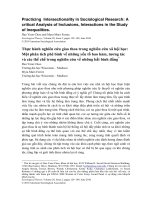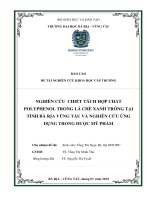NGHIÊN CỨU VỀ VIỆC TÍCH HỢP KỸ NĂNG NGHE, NÓI KHOA NGÔN NGỮ ANH
Bạn đang xem bản rút gọn của tài liệu. Xem và tải ngay bản đầy đủ của tài liệu tại đây (190.92 KB, 32 trang )
HANOI UNIVERSITY OF BUSINESS AND TECHNOLOGY
FACULTY OF ENGLISH LANGUAGE STUDIES
GRADUATION PAPER
A STUDY ON INTEGRATING LISTENING - SPEAKING SKILLS
TO ENHANCE THE SPEAKING SKILL FOR THE THIRD-YEAR
ENGLISH MAJORED STUDENTS AT HUBT
NGHIÊN CỨU VỀ VIỆC TÍCH HỢP KỸ NĂNG NGHE – NĨI ĐỂ
CẢI THIỆN KỸ NĂNG NÓI CHO SINH VIÊN NĂM BA CHUYÊN
NGÀNH TẠI HUBT
HANOI, 2023
HANOI UNIVERSITY OF BUSINESS AND TECHNOLOGY
FACULTY OF ENGLISH LANGUAGE STUDIES
GRADUATION PAPER
A STUDY ON INTEGRATING LISTENING - SPEAKING SKILLS
TO ENHANCE THE SPEAKING SKILL FOR THE THIRD-YEAR
ENGLISH MAJORED STUDENTS AT HUBT
NGHIÊN CỨU VỀ VIỆC TÍCH HỢP KỸ NĂNG NGHE – NĨI ĐỂ
CẢI THIỆN KỸ NĂNG NÓI CHO SINH VIÊN NĂM BA CHUYÊN
NGÀNH TẠI HUBT
Field: English Language
Name:
Student’s code :
Course :
Superviser :
HANOI, 2023
CERTIFICATE OF ORIGINALITY
I, the undersigned, hereby certify my authority of the study project report
entitled “A Study on Integrating Listening - Speaking skills to Enhance the
Speaking Skill for The Third-Year English Majored Students at HUBT”
submitted in partial fulfillment of the requirements for the degree of Bachelor
English Language. Except for the indicated reference, no other person’s work
has been used without due acknowledgement in the text of the graduation
paper.
Hanoi, 2022
1
ACKNOWLEDGEMENT
First and foremost, I would like to express my sincere gratitude to my
supervisor, Ms. Phan
Phương Thúy, for her guidance, stimulating
suggestions, support and encouragement. Without her patience and
understanding, this written work would not have been possible.
Furthermore, I want to extend thanks to the people who took part in the
surveys and provided me with valuable data during this research.
Especially, I am deeply indebted to my friends from Faculty of English
Language Studies and my family who always supported me with patient love,
precious advices and enabled me to complete this work.
Finally, because of limitation of time and knowledge, some mistakes
are unavoidable, thus, I wish to get your understanding and sympathy. I
really expect and highly appreciate your suggestions and contribution to
better my graduation paper.
2
TABLE OF CONTENT
CERTIFICATE OF ORIGINALITY.....................................................i
ACKNOWLEDGEMENT......................................................................ii
TABLE OF CONTENT.........................................................................iii
LIST OF ABBREVIATION..................................................................v
LIST OF TABLES AND FIGURES....................................................vi
PART A: INTRODUCTION.................................................................1
1. Rationale for the study......................................................................1
2. Objectives of the study......................................................................1
3. Research question...............................................................................2
4. Scope of the study...............................................................................2
5. Design of the study.............................................................................2
PART B: DEVELOPMENT..................................................................4
1. Material Collection............................................................................4
1.1. Theoretical background.................................................................4
1.1.1 Overview of listening.....................................................................4
1.1.2. Definition of Speaking..................................................................6
1.1.3. Importance of integrating listening skill and speaking skill....8
1.2. The survey......................................................................................11
1.2.1. Participants..................................................................................11
1.2.2. The survey questionnaire............................................................11
2. Data Analysis.....................................................................................12
2.1. Perception of English majored students at HUBT of integrating
Listening and Speaking skill........................................................................12
2.1.1 Perception of English majored students at HUBT of
integrating Listening and Speaking skill....................................................12
2.1.2. The perception of the importance of interegrating listening
skill and speaking skill..................................................................................13
2.2 The benefits of integrating listening and speaking skill..............13
2.2.1. Enhance background knowledge...............................................13
2.2.2. Put the knowledge of the target language in practical
situations........................................................................................................14
2.2 Challenges of integrating speaking skill and listening skill.....15
2.3. Some suggestions to overcome the challenges...........................16
3. Results................................................................................................17
PART C: CONCLUSION....................................................................20
1. Recapitulation...................................................................................20
2. Limitation of the study....................................................................20
3. Suggestion for further studies........................................................21
REFERENCES......................................................................................22
3
LIST OF ABBREVIATION
Vocab: Vocabulary
P: Page
i.e.: id est (that is)
e.g.: exempli gratia (for example)
HUBT: Hanoi University of Business and Technology
ESL: English as Second Language
EFL: English as a Foreign Language.
4
LIST OF TABLES AND FIGURES
Table 2.1. HUBT third-year English majors’s perception of integrating
listening skill and speaking skill
Table 2.2: The importance of integrating listening skill and speaking skill
Table 2.3: Influence of Vocabulary and Word Expression.
Table 2.4: Benefits of practicing the target language in practical
situations
Table 2.5: Challenges of integrating Speaking skill and Listening skill
Table 2.6: Suggestions to overcome the challenges
5
ABSTRACT
Nowadays, global integration takes huge effects on a wide range of
fields on daily life, thus, there are more and more chances as well as
requirements to communicate with people from other countries in the
world. And English, which is considered as the most common language
used in almost nations and on official cases, become more essential now
than ever. To achieve success in four macro skills; Reading, Writing,
Listening and Speaking, vocabulary is known as the basic constituent; and
how to learn it effectively is a matter faced by every student, particularly in
EFL or ESL context.
Recently, a number of learning methods have been applied by
professors and educators to investigate their effects and also show that
different learners have their own strategy to boost their knowledge. In the
limit of this thesis, some workable and practical modus are mentioned to
help people in concern improving vocabulary in specific and English skills
in general. In addition, it will figure out some wrong routines during this
process and propose some solutions to advance learning approaches. The
findings will hopefully be useful for those who are interested in the topic as
well as for further researches.
1
PART A: INTRODUCTION
1. Rationale for the study
English has long been a common language of the world, just using
English you can communicate with more than 1.5 billion people on this
planet.
English
is
used
everywhere, from
everyday life such as
communication, movies, music ...to international business, conferences and
organizations all use English for exchange. According to the trend of
globalization, it is impossible not to master English.
The English learner, from elementary pupils to students, from worker to
government employers study English with the interest and enthusiasm. But
Vietnamese students, especially the English major students have a lot of
difficulties in learning and practicing English speaking skill. They often fall
into confusion when speaking English because lack of professional
knowledge, confidence, and the good learning method as well. Interesting
extra- activities prevent them from practicing and improving English.
That is the main reason why they do not get the effective result in
learning English, especially the English speaking skill. Due to the above, I
make effective methods in Speaking English by integrating listening and
speaking skill with the hope that this can help the English major students at
Ha Noi University of Business and Technology will study English speaking
skill better in the near future. That is the reason why I decided to choose the
research with the title “A study on integrating Listening - Speaking skills to
enhance the speaking skill for English - majored students at Hanoi University
of Business and Technology
1
2. Objectives of the study
Show the benefits of integrating Listening-Speaking skill to Enhance
Speaking skill for the third-year English majored students at HUBT.
Find out the challenges of students in integrating Listening-Speaking
skill.
Help students to work out their best approach to overcome the
challenges and enhance Speaking skill.
3. Research question
The study is conducted to answer the following questions:
What are the benefits of integrating listening and speaking skill to
enhance speaking skills?
What are the challenges of integrating listening and speaking skill to
learn speaking skills?
What can the students do to integrate listening and speaking skill to
enhance of speaking skill effectively?
4. Scope of the study
The study is about integrating listening and speaking skill to enhance of
speaking skill for the third year English majored students at HUBT. Because
of the limitations of time and knowledge, this study cannot cover the whole
issue of both two skills. It only focuses on the benefits and solutions use
integrating listening and speaking skill to enhance of speaking skill.
Moreover, the study could not touch all the students at HUBT, it was confined
2
to the third year English major students at Hanoi University of Business and
Technology only.
5. Design of the study
The paper is organized as follows:
Part A: Introduction
This part shows the rationale for the study, aims and objectives of the
study, research questions, scope of the study, and design of the study, which
are provided to introduce and server as a basis for the whole study.
Part B: Development
This part consists of three chapters
The first chapter is Theoretical background which provides readers the
definition of listening, speaking, as well as the importance of integrating
listening and speaking skills. Besides, the survey questionnaire and
participant are provided in this part.
The second chapter is Data analysis. In this chapter, I point out the
advantages and disadvantages of integrating listening and speaking skill to
learn speaking skills. Then, i give some strategies to use integrating listening
and speaking skill to enhance of speaking skill for the English major students
at HUBT.
The study is ended with the third part - Results. This part presents an
overview of the study.
Part C: Conclusion
This part is the summation of the major findings, the limitation of the
study, and suggestions for further study
3
PART B: DEVELOPMENT
1. Material Collection
1.1. Theoretical background
1.1.1 Overview of listening
1.1.1.1. Definition of the listening
Listening is a receptive communication skill that involves the process
of creating meaning through understanding and interpretation of messages in
a communication process.
Listening is receiving language through the ears. Listening involves
identifying the sounds of speech and processing them into words and
sentences. When we listen, we use our ears to receive individual sounds
(letters, stress, rhythm and pauses) and we use our brain to convert these into
messages that mean something to us.
Listening in any language requires focus and attention. It is a skill that
some people need to work at harder than others. People who have difficulty
concentrating are typically poor listeners. Listening in a second language
requires even greater focus.
Like babies, we learn this skill by listening to people who already know
how to speak the language. This may or may not include native speakers. For
practice, you can listen to live or recorded voices. The most important thing is
to listen to a variety of voices as often as you can
1.1.1.2. Types of listening
a. Discriminative Listening
4
Discriminative listening is first developed at a very early age – perhaps
even before birth, in the womb. This is the most basic form of listening and
does not involve the understanding of the meaning of words or phrases but
merely the different sounds that are produced. In early childhood, for
example, a distinction is made between the sounds of the voices of the parents
– the voice of the father sounds different to that of the mother.
Discriminative
listening
develops
through
childhood
and
into
adulthood. As we grow older and develop and gain more life experience, our
ability to distinguish between different sounds is improved. Not only can we
recognize different voices, but we also develop the ability to recognize subtle
differences in the way that sounds are made – this is fundamental to
ultimately understanding what these sounds mean. Differences include many
subtleties, recognizing foreign languages, distinguishing between regional
accents and clues to the emotions and feelings of the speaker.
Being able to distinguish the subtleties of sound made by somebody
who is happy or sad, angry or stressed, for example, ultimately adds value to
what is actually being said and, of course, does aid comprehension. When
discriminative listening skills are combined with visual stimuli, the resulting
ability to ‘listen’ to body-language enables us to begin to understand the
speaker 7 more fully – for example recognizing somebody is sad despite what
they are saying or how they are saying it.
“Imagine yourself surrounded by people who are speaking a language
that you cannot understand. Perhaps, passing through an airport in another
country, you can probably distinguish between different voices, male and
female, young and old and also gain some understanding about what is going
on around you based on the tone of voice, mannerisms and body language of
the other people. You do not understand what is being said but using
5
discriminative listening to gain some level of comprehension of your
surroundings.”
b. Comprehensive Listening
Comprehensive listening involves understanding the message or
messages that are being communicated. Like discriminative listening,
comprehensive listening is fundamental to all listening sub-types.
In order to be able use comprehensive listening and therefore gain
understanding the listener first needs appropriate vocabulary and language
skills. Using overly complicated language or technical jargon, therefore, can
be a barrier to comprehensive listening. Comprehensive listening is further
complicated by the fact that two different people listening to the same thing
may understand the message in two different ways. This problem can be
multiplied in a group setting, like a classroom or business meeting where
numerous different meanings can be derived from what has been said.
Comprehensive listening is complimented by sub-messages from nonverbal communication, such as the tone of voice, gestures and other body
language. These non-verbal signals can greatly aid communication and
comprehension but can also confuse and potentially lead to misunderstanding.
In many listening situations it is vital to seek clarification and use skills such
as reflection aid comprehension.
1.1.2. Definition of Speaking
There are a lot of definitions of the word “speaking” that have been
suggested by linguists and researchers in language learning.
Nunan (1995) stated that speaking is “to say words orally, to
communicate as by talking, to make a request, and to make a speech.” Chaney
6
(1998) defined speaking as the process of creating and sharing meaning using
verbal and non-verbal signs in different contexts. According to Brown (1994),
Burns and Joyce (1997), speaking is an interactive process involving the
production, reception, and processing of information, for the purpose of
creating meaning.
Bygate (1987) defined speaking as “the production of auditory signals to
produce different verbal responses in listeners”. It is considered the
systematic combination of sounds to form meaningful sentences. Eckard and
Kearny (1981), Florez (1999), and Howarth (2001) defined speaking as a
two-way process including a true communication of opinions, information, or
emotions. That is, speaking is a collaboration between two or more people in
shared time and shared context.
To sum up, all the definitions are given with a view to clarifying the
nature of the speaking skill which is necessary for the process of acquiring a
native language or a foreign one.
Although there are two kinds of language used in communication,
writing and speaking, speaking is considered the most important language
used in daily life. People all over the world use spoken language to
communicate with others in all their activities. They keep their relationship
with the other by talking. Speaking plays a very important role in all aspects
of life.
There are two forms of speech, dialogue and monologue. A monologue is
performed by one person and is used to express feelings or express ideas and
information, such as in speech, news, and storytelling. Dialogue held by two
or more people to interact with others, such as in trading, conversation,
classroom teaching and learning, etc.
7
According to Thornburny (2005), speaking is so much a part of daily life
that we take it for granted. Pawlak et al. (2011) stated that speaking a foreign
language is a very complex skill, including vocabulary; grammar,
pronunciation, and fluency, the ability to structure talk, or even non-verbal
abilities.
According to Harmer (2001), in both first and second languages,
speaking is a skill that deserves as much attention as literary skill. Speaking
proficiency is the most important aspect of learning a foreign language or a
second language, success measured by the ability to carry on a conversation
in that language.
In short, speaking must contain a meaning that is acceptable to others.
Therefore, we must know how to speak properly. Besides grammar, we
should also know how to use words at the right time and in the right place.
1.1.3. Importance of integrating listening skill and speaking skill
According to Cambridge dictionary, “integrate” is to combine two or
more things to make something more effective. In this case of study,
integrating listening and speaking means combine listening and speaking to
enhance speaking skill more effectively.
The incorporation of listening and speaking can facilitate metacognition
development of learners. Metacognitive knowledge involves thinking about
the language learning process; hence, learners can regulate and direct their
own learning. Findings indicate that metacognitive awareness can potentially
improve learners’ listening skills because it helps them become more
motivated as well as influences their listening performance (Goh, 2008).
Research also has shown further evidence that indicates the effects of
metacognitive awareness on the outcome of listening comprehension in
communication (Goh, 2008).
8
In addition, the integration of listening and speaking can be used for the
advancement of listening content. In the pre-listening phase, for instance,
learners stand a better chance of improving comprehension when they are
asked to discuss the content for the purpose of perceiving the material.
According to schema theory, learners construct meaning by activating their
prior knowledge and connect the existing knowledge to activate new learning
(Mansouri & Mantero, 2019; Nassaji, 2002). Also, the use of listening content
in the post-listening stage can serve as a springboard for learners for further
language practice and leads to deeper learning.
Listening provides input in second language acquisition for coming to
good terms with grammatical structures, lexical units, and phonological
awareness. Assigning students to do a speaking activity after listening is a
useful way to push them to put their knowledge of the target language in
practical situations. Exposing learners to the target language can encourage
them to use it more independently. According Mart (2019) Immersing them in
a realistic setting allow them to practice speaking boosts their confidence.
Integration of skills exposes English language learners to authentic language
and challenges them to interact naturally in the language. By this way,
English becomes a real means of interaction and sharing among people.
Hubbard, et al. (1983) emphasized the role of listening in speech
improvement by stating that “without actually having been taught to listen, a
student may be able to express himself orally, but he will never be able to
communicate with speakers of English if he is unable to understand what is
said to him” (p. 30).
The attainment of proficiency in oral production hinges upon four
fundamental processes: Conceptualization, Formulation, Articulation, and
Self-monitoring (Levelt, 1989). While conceptualization refers to background
knowledge, formulation deals with language skills which are considered a
9
requisite to speaking effectively. Articulation draws on pronunciation,
whereas self-monitoring focuses on self-repair in speech production. Within
this framework, listening is essential for learners to enhance their background
knowledge, vocabulary and grammar repertoire, and accurate pronunciation
for advanced language learning. Furthermore, the use of bottom-up and topdown processing for promoting listening skills provides additional
opportunities for learners to focus on linguistic form.
Listening provides input in second language acquisition for coming to
good terms with grammatical structures, lexical units, and phonological
awareness. Assigning students to do a speaking activity after listening is a
useful way to push them to put their knowledge of the target language in
practical situations. Exposing learners to the target language can encourage
them to use it more independently. Moreover, immersing them in a realistic
setting to allow them to practice speaking boosts their confidence (Mart,
2019).
Based on the previous surveys, this study is based on two last surveys
to explore the benefits of integrating listening and speaking skill for the third
year English majored students at HBUT.
1.1.4. Benefits of integrating listening and speaking skill
The attainment of proficiency in oral production hinges upon four
fundamental processes: Conceptualization, Formulation, Articulation, and
Self-monitoring (Levelt, 1989). While conceptualization refers to background
knowledge, formulation deals with language skills which are considered a
requisite to speaking effectively. Articulation draws on pronunciation,
whereas self-monitoring focuses on self-repair in speech production. Within
this framework, listening is essential for learners to enhance their background
knowledge, vocabulary and grammar repertoire, and accurate pronunciation
for advanced language learning. Furthermore, the use of bottom-up and top10
down processing for promoting listening skills provides additional
opportunities for learners to focus on linguistic form.
1.2. The survey
1.2.1. Participants
The data utilized in this research paper was gathered from a survey
carried out among 100 HUBT third-year English majors who are 50 males
and 50 females in classes TA24-04, TA24-06, TA24-07, TA24-08, TA 24-16
on 15th June, 2022. Then, the answers were collected at the same day.
1.2.2. Methods
This paper is conducted according to Quantitative Methods. A
questionnaire with multiple choice questions was given to the target population.
1.2.2. The survey questionnaire
The survey questionnaire consists of 9 questions; divided into two main
parts: one is for personal details and one for facts and opinions. Personal
details include 3 questions about general information of the participants.
Facts and opinions are for the purpose of clarifying three research questions
studying the use integrating listening and speaking skill to enhance of
speaking skill of English major juniors at HUBT. The first part of the
questionnaire with two questions is to get the perception of English majored
students of integrating listening and speaking skill to learn speaking skills of
third-year English majored students in HUBT. The third and the fourth
question are to answer the benefit of integrating. The fifth question shows the
challenges of integrating listening and speaking to learn Speaking skill. The
last part of the questionnaire, the method to use integrating listening and
speaking skill to enhance of speaking skill.
11
2. Data Analysis
2.1. Perception of English majored students at HUBT of integrating
Listening and Speaking skill.
2.1.1 Perception of English majored students at HUBT of integrating
Listening and Speaking skill.
For you, what is integrating listening Number
skill and speaking skill?
Percentages
Combining listening and speaking at the 60
same time
60%
Listening before speaking
20
20%
Speaking before listening
15
15%
I do not know about integrating listening 5
skill and speaking skill
5%
Table 2.1. HUBT third-year English majors’s perception of integrating
listening skill and speaking skill
The table 2.1 presents for HUBT third-year English majors’s perception of
integrating listening skill and speaking skill. There are four sentences to answer
the question about integrating listening and speaking skill. In which, the highest
is “combining listening skill and speaking skill” with three-fifths participants;
and the people who do not know about integrating listening and speaking is
lowest (5%). The other belongs to listening before speaking (20%) and speaking
before listening (15%). This means that the HUBT third-year English majored
students have good knowledge about integrating.
2.1.2. The perception of the importance of interegrating listening
skill and speaking skill
How do you rate the importance of Percentages
integrating listening and speaking skills?
12
Moderately important
Very important
Important
Slightly important
Not important
7%
70%
15%
5%
3%
Table 2.2: The importance of integrating listening skill and speaking skill
Table 2.2 displays data on students' perceptions of the importance of
integrating listening and speaking skills to hen cane speaking skill with a
classification into five levels, from moderately important to not important. It is
clear that the number of students who rated English speaking skill as very
important has the highest percentage with seven-tenths and the number of
students who thought English speaking skill as not important has the lowest
percentage, with only 3%. It suggests that almost every students participating in
this study are aware of the importance of integrating listening skill and speaking
skill to improve speaking skill.
2.2 The benefits of integrating listening and speaking skill
2.2.1. Enhance background knowledge
How can integrating listening and speaking skill help you enhance
background knowledge?
Percentages
Raising vocabulary
50%
Improving grammar
10%
Improving pronunciation
40%
Table 2.3: Influence of Vocabulary and Word Expression.
What is shown in the table 2.3 is factors which help students enhance
their background knowledge through integrating Listening and Speaking skill.
A half of participant agreed that they can raise vocabulary based on
integrating these skills. Nearly the same with vocabulary, improving
13
pronunciation ranks at the second position with two-fifths of the participants’
selection. And the final is improving grammar which is the lowest choice with
only 10% selected.
2.2.2. Put the knowledge of the target language in practical situations
What is the benefits of putting the knowledge of the target
language in practical situations when integrating listening
and speaking skill?
Number
Percentages
Exposing learners to the target
60
60%
Immersing students in a realistic setting
36
36%
Others
4
4%
Table 2.4: Benefits of practicing the target language in practical
situations
The table 2.4 shows that the benefits of practicing the target language
in practical situations. It is oblivious that exposing learners to the target is the
highest selection with three-fifths participants. Besides, the participants can
be immersed in a realistic setting when integrating listening and speaking
skill, so that they can improve their speaking skill; which is selected by more
than one-thirds of total participants. This results are nearly the same with
research of Mart (2019): Listening provides input in second language
acquisition for coming to good terms with grammatical structures, lexical
units, and phonological awareness. Assigning students to do a speaking
activity after listening is a useful way to push them to put their knowledge of
the target language in practical situations. Exposing learners to the target
language can encourage them to use it more independently. Moreover,
immersing them in a realistic setting to allow them to practice speaking
boosts their confidence.
14
2.2 Challenges of integrating speaking skill and listening skill.
What are your difficulties in integrating Speaking skill
and Listening skill?
Percentages
1. Lack of background knowledge
12%
2. Lack of facilities
20%
3. Lack of environment
64%
4. Other
4%
Table 2.5: Challenges of integrating Speaking skill and Listening
skill
The table 2.5 presents for challenges of English majored students at
HUBT in integrating listening skill and speaking skill. More than three-fifths
participants choose that they are lack of environment. When being students at
high school, they tried to learn grammar to overcome English tests; they
ignore listening and speaking skills. This is the main reason that leads to
unconference in communicating, learning inside classroom is not enough for
them to practice while some have problems with facilities which are selected
by one-fifths of students. These students are normally lack of facilities such
as: laptop, internet, and so on. Next is lack of background knowledge
including grammar, vocabulary, pronunciation and so on. It has small part
with 12%. This indicates that the input of HUBT for English majored students
is quite hopefully for the future. Finally, the other give their opinion that they
have other problems such as unconfident, nervous, poor listening skill. Thus,
it is recommending that students should understand about the difficulties and
overcome the problems in speaking skill and listening skills as soon as
possible.
2.3. Some suggestions to overcome the challenges.
What should you do to overcome the challenges to Percentages
15
integrate speaking skill and listening effectively?
Create the environment to practice
60%
Learn through social network
70%
Listen to favorites movies or songs
90%
Practice Speaking as much as possible
68%
Record your voice
50%
Table 2.6: Suggestions to overcome the challenges
Somethings are shown in the table 2.6 are quite hopeful for both
dynamic and shy students. The result shows that these suggestions are very
useful for them, because they can practice speaking based on their
characteristic at everywhere and anytime. It is the reason why “Listen to
favorite’s movies or songs” and “Learn through social network” are selected
the most.
Listening to favorite movies or songs is highest, which is selected by
majority participants. This is the best way for very students, who are shy in
communicate directly; even people can practice everywhere at any time.
When people listen to movies or songs, their ears is not only listen, but also
unconsciously receive information; this creates English environment naturally
and help them improve listening skill as well as speaking skill. Listening to
English songs can help listeners master and use certain grammar patterns
correctly in everyday conversation. Besides, listening to English songs is the
great way to improve pronunciation and accent. Because singing along with
favorite English songs helps students to reduce the accent and learn more
about how to link words together when they speak, which greatly improves
their pronunciation. In addition, watching movies is a great way for you to
improve English, especially listening and speaking skills. Films are not
usually created for English language learners – they are made for native
English speakers. Therefore, the language is exactly how you hear it in real
16
life – it is spoken quickly, with native accents and pronunciation and using
many idioms and colloquial expressions. This will help students to raise
vocabulary when speaking and diversify context when listening.
Learning English through social network is quite high choice. In the
fact that, almost students have their own technology equipment such as
mobiphone, laptop or computer, etc. It is easy for them to connect or access
social network. Social network is an information system that provides the
network user community with services of storing, providing, using, searching,
sharing and exchanging information with each other, including the service of
creating personal websites, forums, chat online. Through social network they
can join group chat of English to enhance their speaking skill, or even video
call with foreign friends.
Next, one of the effective ways is “practice speaking as much as
possible”. Firstly, they can talk with your friends who are English majored
students or who are interested in learning English. Even, they can try to get
over speaking English twenty-hour challenge.
Finally, “Record your voice” are 50% which is the smallest selection;
however, it is also an effective method to help students use integrate
Listening skill and Speaking skill to enhance Speaking skill. When you record
your voice and listen again to check, this impacts both your two skills. If you
make mistakes, you can know and improve or fix these errors to be a good
speaker.
3. Results
Based on the survey above, the paper obtained the following results
Based on the survey above, the paper obtained the following results:
The first is the perception of integrating listening and speaking skill. The
results show that being the third year students of Faculty of English Language
17









